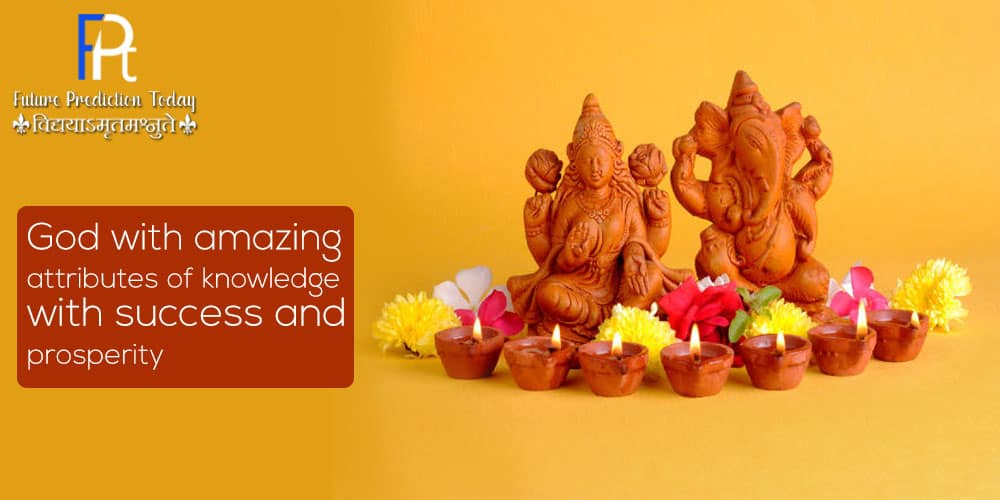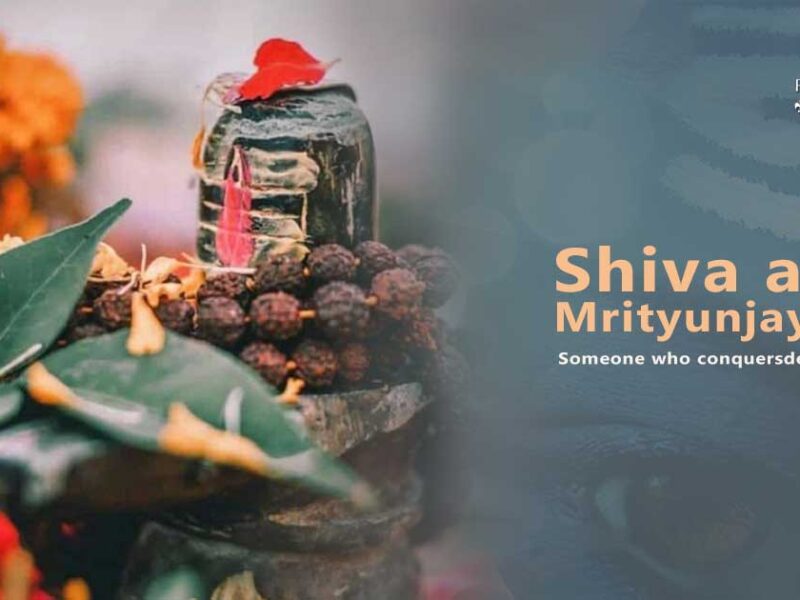The first mention of Ganpati is in the Rig Veda. He is referred as Gananam pati which means that he is the lord of all ganas or forms of creation. This includes the devtas, gods, brahmands, sapt Rishis, galaxies and constellations or Nakshastras. He is the leader.
Gam stands for eternal knowledge.
Nam for one who gives liberation.
In the Vedas he is referred to as the Nirakara Para Brahma Swarupa who is the Supreme consciousness himself. He is the one who blesses us with knowledge and liberation from all negativities and narrowness.
The well-known mantra from Rig Veda-
गणानां त्वा गणपतिं हवामहे
कविं कवीनामुपमश्रवस्तमम् ।
ज्येष्ठराजं ब्रह्मणां ब्रह्मणस्पत
आ नः शृण्वन्नूतिभिः सीद सादनम्
This Mantra of Rig Veda is addressed to Brihaspati or Brahmanaspati)
1: Among the Ganas Ganapati, we offer our Sacrificial Oblations,
2: You are the Wisdom
3: Please come to us by Listening to our Invocation and be Present in the Seat of this Sacred Sacrificial Altar to charge our Prayers with Your Power and Wisdom.
There is a verse referring to him as the Vakrtunda, one with the tusk.
In the Vedas he does not come across as the present elephant headed and pot-bellied Ganesha.
Ganesha Puran
The Ganesha Purana with Ganapati Upanishad are the two most important texts of the Ganapatya sect of Hinduism who consider Ganesha as their primary deity. It is about Lord Ganesha, who is the most worshipped god in Hinduism, and revered as the god of new beginnings. The text has stories of Parvati birth, marriage to Shiva, Kartikey’s birth and birth of Ganesha.
Vighanharta, Siddhivinayak, Brahmanaspati
During our lifetime we embark on many projects; which could be as simple as going to school, moving into a new home, getting married or entering into a new profession. Whenever we do so we are haunted by the fear of failure or of something going wrong along the way and so we wish for a smooth beginning. That is why we invoke Lord Ganesha at the onset of a new beginning as he ensures an auspicious start without obstacles.
Why is Ganesha
Let us look at some interesting facts about Ganesha…
The portrait of Ganesha that comes to our mind is most often of a cute and cuddly God with an elephant head, and a prosperous stomach. He comes across as being happy go lucky, enjoying his modak, but you will be surprised to know that he is an avatar or descendent of Parahbrahma Ganesh- one who has no birth. He is Anadi and Anant, someone without a beginning or an end.
Did you know that Lord Ganesha was worshipped during the wedding of Shiva and Parvati as Parahbrahma Ganesha, who has no birth?
He is mentioned in the Rigveda and Yajurveda as the Brahmanaspati, personification of piety and religion, lord of expansion and growth like Brihaspati or the guru of the devtas.
He’s normally seen riding a mouse. Ever wondered why?
Ganesha is connected to agriculture and prosperity. In historic times, land and agriculture were the main sources of income and rodents were often a menace to agriculture. Therefore, he controls the rat by riding it, thereby removing obstacles faced by tillers of land and agriculture and farmers, and becomes symbolic of prosperity.
Lord Ganesha wrote the epic Mahabharata
One of the stories related to Ganeshji is that he wrote epic, Mahabharata without stopping. It was narrated to him by Muni Ved Vyas and there was an agreement between them: Ved Vyas rishi could not stop his dictation. On the other hand Lord Ganesh had to understand before he wrote.
So why should we pray to him?
Ganesha, with his elephant head, represents immense knowledge, infinite memory and wisdom. By praying to him, we invoke and inspire these qualities within us.
These qualities are essential to acquiring name, fame and success in anything we do. Before any other resource, one needs the right knowledge to act and probably that’s the reason, Ganesha is first worshipped as the Pratham Pujya.
Why are his wives Riddhi and Siddhi and sons Shubh and Labh?
Intelligence or expertise in any field equals Siddhi. Siddhi in turn helps us gain wealth, which is Riddhi. Shubh is auspiciousness and Labh refers to benefits and gains. An auspicious atmosphere filled with sound knowledge leads us towards not just mental and physical well-being but also financial prosperity.
Interesting Temple
An interesting temple of Lord Ganesha is the Trinetra Ganesha temple, situated in the Ranthambhore.
National Park in Rajasthan. It is a popular and an old tradition to send the first wedding card here to seek the Lord’s blessings for any marriage in the family. I sent both my daughter’s wedding cards here and wished for the ceremonies to be completed seemlessly.
And that is exactly what we were rewarded with.When I visited the temple, I saw huge sacks filled with wedding cards lying there. Several kilos of cards come here everyday, making it a very special temple of Lord Ganesha.
Ganesh Chaturthi
“Vinayakam veda priyaha bhadrapada chaturthi yajna maha priyaha.”
On the auspicious day of Ganesh chaturthi, performing yagya, puja and austerities ensures the blessings of Lord Ganesha. It is a belief that worshiping him one will feel abundance in their life.
He resides in the mooladhara chakra and guides the opening of the kundalini Shakti. Number three is associated with him- three states of Jagriti, svapana and sushupti which is deep sleep.
He is beyond the three bodies- Stula, Suksma and karana. Outer, inner conscious and covers the inner most self.
He is beyond three time periods- bhut, vartamana and Bhavishya.
Ganesh Chaturthi
This is the 4th day of every moon cycle and is very auspicious for performing havan with mantra repetitions. He was born on this day to Parvati MA.
Ways of worshipping
Some people bring Ganesha home and some go to temples and pandals to worship him. Some worship to the Ganesh idol they already have.
You can bring Ganesha home for 11/2 days, 3 days, 5days, 7days or 10 days. When you bring Ganesha home you have to keep him like a guest in your house by offering him prashad, doing his puja and Arti morning and evening.
Decorating the house, calling friends over for bhajan evening and celebrating his home coming. His departure is equally important and done with pomp and show and sadness and signifies that everything that begins has to come to an end like birth and death. Visarjan after sthapana is done in Hinduism keeping in mind this concept.
Though because of pollution due to material used in idols and chemicals in paints, visarjan is being discouraged or natural idols are being replaced which might not be very attractive but are Eco friendly.
One very popular and fructifying offering is to offer 108 or 1008 modaks while chanting his names.
He removes all obstacles and grants Riddhi, siddhi and wisdom. Repeating Om Gam Ganpataye Namah! Elevates one spiritually.
Durva is a special type of sacred grass. The word Durva is derived from the words duhu and avam.
Duhuavam means that which is far away and means that which brings closer. According to this meaning, Durva is that which brings the distant pure spiritual particles (pavitraks) of Shri Ganeshji.
Durva and it’s spiritual features…
1/ The Durva have the ability to absorb and emit the three Principles of Shiva, Shakti and Ganesh.
It’s effects
- The Nirgun Ganesh Principle are emitted through the Durva.
2/ The effect of the frequencies emitted by the Durva is at the subtle level.
Type of Durva and the auspicious number that should be offered to invoke Lord Ganesha…..
Tender Durva are used in the worship of Lord Ganesh. Offer the Durva with three or five leaflets. These are called durvankur. The middle leaflet of durvankur attracts the Principle of Ganesh and the other two leaflets attract Shiva and Shakti Principles.
Method of offering Durva
The minimum number of Durva to be offered to Ganesh Ji should be twenty-one. You can tie the Durva together and offer them to Lord Ganesha after dipping into water.
Durva Archana
Lord Ganesh is worshipped by offering one Durva at a time and reading one thousand names of Shri Ganesh along with it. This is called ‘durvarchan’. In this the Durva offering starts from the feet and goes upwards towards the face of the idol.
What all does he bless us with—
First and foremost he removes obstacles and clears the path to success.
He is wisdom himself and his elephant head has the capacity of holding large memories. If one has the attribute of wisdom one can attain success in anything one does.
His wives represent success and perfection in whatever we do thus Siddhi. Riddhi represents prosperity and abundance of wealth.
His sons Shubh and Labh represent earnings and shubh ta.
Ganpati baba represents Mercury in Vedic astrology and therefore praying to him we are blessed with business and financial acumen, good communication skills both written and oratory, reasoning, logic and knowledge.
A well placed strong Mercury is seen in the horoscope of writers, actors, astrologers, media persons, mathematicians, chartered accountants, dealers, brokers and businessmen. Many known artists and salespersons also possess good Budh or Mercury in their horoscope all blessings of Lord Ganapati.
Ganapati puja is most popular in the state of Maharashtra since Shivaji’s times. You will notice that it is the financial capital of india and the centre of the film industry too.
Keep taking his name and receive his blessings in abundance.




